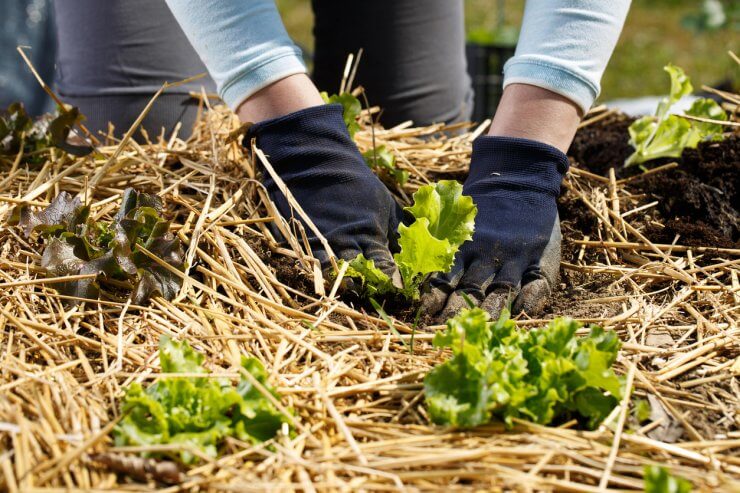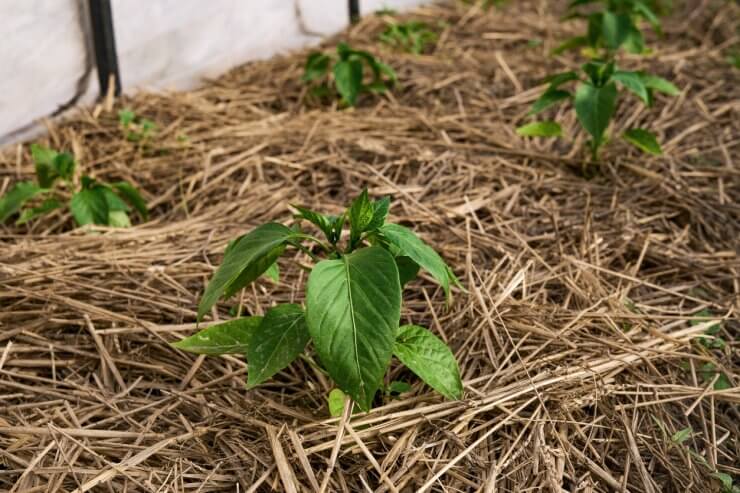
To talk about the best plants for straw bale gardening, it’s probably important to clarify what straw bale gardening is exactly. The short version is that you can grow vegetables in straw bales just as you would in a raised bed or large container. It’s a popular option in areas where the soil is contaminated or simply not conducive to growing plants. It’s also popular in vertical gardening.
It’s also generally less expensive than a raised bed since that requires supplies and probably soil. Straw bale gardening is also incredibly eco-friendly since your growing medium will turn into compost.
Discover 7 top tips for growing, harvesting, and enjoying tomatoes from your home garden—when you access the FREE guide The Best Way to Grow Tomatoes, right now!

Discovering the best plants for straw bale gardening
Because straw bales make good insulation and heat up as they slowly decompose, heat-loving plants are some of the best plants for straw bale gardening.
1. Bush beans. Beans don’t like waterlogged soil, and they do enjoy warmth, making them ideal for growing in straw bales.
2. Summer squash. You can plant 2 to 4 summer squash plants in each straw bale, meaning you could grow enough squash to fuel a small army.
3. Eggplants. Eggplants love warm temperatures, making them one of the best plants for straw bale gardening.
4. Peppers. Like eggplants, peppers love warm conditions. Plus, there are so many varieties, from slightly sweet to unbearable heat.
5. Strawberries. Yes, it’s best to avoid perennials in straw bale gardening. However, since strawberries can take over your yard, planting them in a straw bale is an easy way to isolate them and keep them in check.
6. Tomatoes. I think we all know how much tomatoes love that warm, sunny weather. Just be sure to keep them watered regularly.
7. Lettuce. Because lettuce is awesome, and you can plant new lettuce every couple of weeks or so.
8. Spinach. Spinach is very easy to grow, and it’s really good for you. Plus, you can harvest spinach in just a few weeks.
9. Garlic. You can get a lot of garlic in a small amount of space, so this is a nice one for straw bales.
10. Basil. Any herb works, but I love basil, and it’s an ideal companion plant if you decide to grow tomatoes.
Discover 7 top tips for growing, harvesting, and enjoying tomatoes from your home garden—when you access the FREE guide The Best Way to Grow Tomatoes, right now!
The pros and cons of straw bale gardening
Like anything, there are some pros and cons to this approach to gardening. Here’s what comes up most often for people.
Pros
- Inexpensive
- Biodegradable
- Good option if you have to plant on a patio or pavement
- As the straw breaks down, it nourishes your vegetables
- No problems with weeds
- Easier to reach your plants since they are 18-24 inches off the ground
- Plant roots stay warm
Cons
- The straw completely breaks down into compost within two years
- You need to condition the straw bales before planting
- It dries out quickly, so you need to take care with watering
- Root crops and perennials aren’t the best plants for straw bale gardening (although root crops do enjoy the partially decomposed second-year bales)
- You will need to add fertilizer since the straw doesn’t supply any nutrients until it begins to break down
Discover 7 top tips for growing, harvesting, and enjoying tomatoes from your home garden—when you access the FREE guide The Best Way to Grow Tomatoes, right now!
5 Quick tips for straw bale gardening
1. Position your straw bales “pointy” side up. You’ll know what I mean once you get your bales. Placing the cut or “pointy” side up allows water and nutrients to get into the bale more easily.
2. Condition your straw bales. Before you plant anything, soak your bales with your garden hose once a day for three days. For the next 4 to 5 days, water and use a fertilizer high in nitrogen. Then for the next 6 to 8 days, water the bale. This should get it ready to support your plants.
3. Be careful to get straw and not hay. They can look very similar, but hay often contains weeds.
4. Take advantage of the space! You can plant smaller herbs and flowers into the sides of the bales.
5. Follow the seed packet instructions. Be sure to space your vegetables just as you would if you were planting in soil.
Discover 7 top tips for growing, harvesting, and enjoying tomatoes from your home garden—when you access the FREE guide The Best Way to Grow Tomatoes, right now!
All in all, there’s not much that you can’t grow in a straw bale, and the “rules” are pretty much the same as they are with any other style of gardening. So if you have extra space in your driveway, your soil isn’t great, or you just want to try something new, call your local farm or garden supply store and give straw bale gardening a try!
Have you tried straw bale gardening? I’d love to read about your experience in the comments.





I live in a really old house that lets in a great deal of cold air around the base of the house. We have decided that next fall we are putting straw bales around the house for added insulation. I was going to try composting them in the spring, but now I think I will plant in them one year and then compost the following (or whenever they start to break dowm). I love this idea for added garden space and less waste.
Great idea if you have access to straw bales on the cheap. Checked a local garden center the other day it was with sales tax 12 bucks per bale. Once over sticker shock all the additional pros appear to make it worthwhile
I WAS ABLE TO GROW ZUCCHINI BUT NO TOMATOES, PEPPERS, OR WATERMELONS. IT WAS SO HOT THAT THE OTHER THINGS JUST DRIED UP, EVEN WITH WATERING. i LIVE IN NORTH EAST ARKANSAS. IT WAS SUCH A BUMPER CROP OF ZUCCHINI I EXPERIMENTED WITH MAKING ZUCCHINI JELLY. THE JELLY WAS VERY GOOD; I USED JELLO AND KOOL-AID FLAVORINGS.
This is now on my list for the spring! Sandra
Trying this for the first time this year. I got my bales from a local farmer who plants 30 acres of wheat each year and creates about 5000 bales of wheat straw annually. He does not use any pesticides or even more important for SBG, no aminopyralids to suppress broad leaf weeds. I am excited!
What about the pesticides in the straw? Can you even get organic straw?
Try to find a local farmer, then you can talk directly to the grower and know what they use.
I’m planting in straw bales for the first time. Excited to see my veggies grow!
I’ve grown tomatoes, winter squash and zucchini in mine. After they decompose I used it between my rows to keep weeds down and mulch. Just be sure you get it from a feed store.
Great tips!